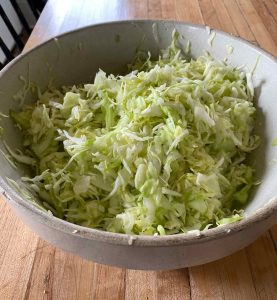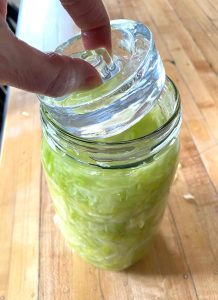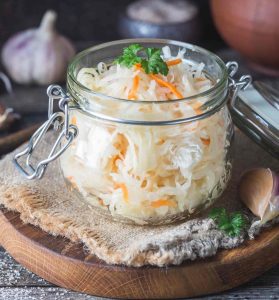Easy Sauerkraut Recipe
Easy Sauerkraut Recipe

This easy sauerkraut recipe uses a method called fermentation. It specifically is called Lacto-fermentation. (This resource talks a little more about it).
The Fermentation Process
Traditional lacto-fermentation involves submerging vegetables in a brine solution— salt and water. There are also methods of fermenting without added salt. The salt-brine method involves two stages:
First Stage of lacto-fermentation, vegetables are submerged in a brine that is salty enough to kill off harmful bacteria. The Lactobacillus (friendly bacteria) survive this stage and begin stage two.
Second Stage of lacto-fermentation, the Lactobacillus organisms begin converting lactose and other sugars present in the food into lactic acid. This creates an acidic environment that safely preserves the vegetables – and gives lacto-fermented foods their distinctive tangy flavor. (That link has some additional wonderful fermented recipes.)
Fermentation is Different from Canning
While lacto-fermentation is a common and traditional form of pickling and preserving vegetables, it is not the same thing as canning and is not used for long-term preservation. Many fermented foods are edible for two months or more, and their flavors develop and become more acidic over time. Typically, you begin eating a fermented food once it has reached the desired level of fermentation and you finish it before the end of its “shelf life,” during which time the flavors will mature and change.
By contrast, canning involves some form of sterilization and is intended to preserve food in its canned state for long periods, often for 6 months to a year or more.
It is important to mention here, that most of the enzymes are lost during the canning process. Even though some of the nutrition may still be somewhat in the canned foods, it isn’t necessarily as nutritious in that it isn’t as usable in the body as a fermented food.
Fermenting Vegetables
This is my process of fermenting vegetables (not sauerkraut):
1-3 tablespoons per quart of water to make a brine to pour over vegetables in a mason jar and allow to sit for a period of time (from 3 days to a month, depending on the vegetable- I’ll do a separate blog on different vegetables in the future).
Back to the recipe of making easy sauerkraut. Brine is what I use for my other fermented vegetables. However, my process for sauerkraut is a little different.
Making an Easy Sauerkraut Recipe
I will add 1-2 teaspoons of sea salt to a large bowl of shredded cabbage. A medium-sized cabbage will make a good amount to put into a quart jar.
Massage the cabbage with the salt until the liquid starts to release.

Shred cabbage to look like you would imagine cole slaw to look like.
Let the cabbage rest for 10 minutes and massage it again. Repeat as often as necessary until the cabbage is juicy and you see liquid forming at the bottom of the bowl.
Pack the mixture firmly into a large jar, crock or bowl. Press the cabbage down until the liquid arises above the cabbage, about 1/4 of an inch.
Next you will apply weight to hold the vegetables down under the liquid. You can find nice jar weights here, but you could also use another type of weight if you are making kraut in a crock or a bowl. Cover the jar or bowl with a clean dish towel. Alternatively, you can cover with a lid on the jar. If you use a lid, you will need to “burp” the kraut, or unscrew the lid, every day to make sure the gases do not build up.

Use a fermenting weight to keep juices above the cabbage.
Fermenting Time
Allow the sauerkraut to ferment for 3 days to 14 days, depending on how sour you would like it. Put a lid on the final sauerkraut and keep in the refrigerator for several months. It may continue to get a little more sour but the cooling will slow it down.
Feel free add different seasonings to your sauerkraut, such as carrot or caraway seed. Other options to add are garlic, onions, radishes or whatever vegetables you’d like to experiment with. You can ferment onions or chives with the cabbage but keep in mind it can be more versatile by itself. Let me know what you think in the comments below. Enjoy!
See my recipe for Fermented Cranberries here!
Equipment list:
Food Processor for Shredding Cabbage
Shop all Pampered Chef products here
Some links are affiliate links, which means I make a small commission at no extra cost to you. See more info here.
Most of the enzymes are lost during the canning process. Even though some of the nutrition may still be somewhat in the canned foods, it isn't necessarily as nutritious in that it isn't as usable in the body as a fermented food. This sauerkraut recipe
Ingredients
1 medium head of cabbage
1-2 tsp salt
Instructions
1. Add 1-2 teaspoons of sea salt to a large bowl of shredded cabbage. A medium-sized cabbage will make a good amount to put into a quart jar.
2. Massage the cabbage with the salt until the liquid starts to release.
3. Let the cabbage rest for 10 minutes and massage it again. Repeat as often as necessary until the cabbage is juicy and you see liquid forming at the bottom of the bowl.
4. Pack the mixture firmly into a large jar, crock or bowl. Press the cabbage down until the liquid arises above the cabbage, about 1/4 of an inch.
5. Apply weight to hold the cabbage down under the liquid. Cover the jar or bowl with a clean dish towel. Alternatively, you can cover with a lid on the jar. If you use a lid, you will need to "burp" the kraut, or unscrew the lid, every day to make sure the gases do not build up.
Allow the kraut to ferment for 3 days to 14 days, depending on how sour you would like it it.

Prep time: 20
Cook time:
Total time: 14
Servings:
Serving size:
Meal type: Lunch, Dinner, Sidedish, Appetizer, Fermented, Raw
Special Equipment needed: food processor, jar or crock with fermenting weights or other weight
